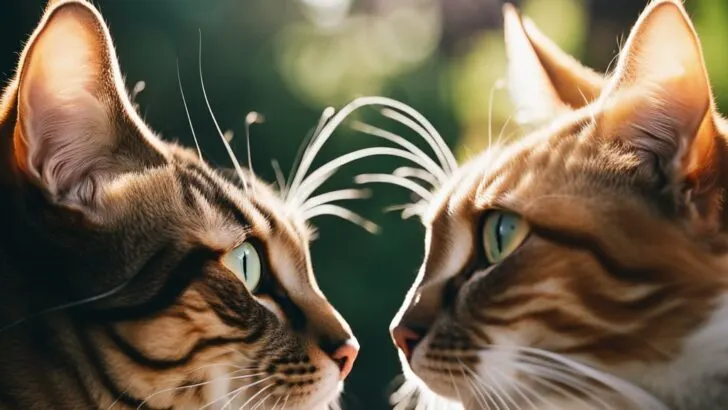Cats call to each other as a form of communication that varies in message and intent, much like how people use different tones and words to convey their feelings. When your cat emits a soft trill or a gentle meow, it might be trying to greet another cat or signal a friendly intention to play.
These vocalizations can also serve as a way for cats to establish social hierarchies or territorial boundaries. For instance, a cat’s persistent meow at another can be its way of asserting dominance or discomfort within a shared space.

Understanding cat communication is not just about the sounds they make; it’s also about interpreting the silent signals they give. You might notice your own cat subtly flicking its tail or changing its ear orientation when interacting with other felines.
These quiet cues can speak volumes about what your cat is thinking or feeling. A straight-up tail can signal happiness or confidence, while an aggressively swishing tail might mean it’s best to give your cat some space.
If you’ve ever watched two cats approach each other, you’ve perhaps observed a delicate dance of head bobs and nose touches. These movements are all a part of how cats navigate their complex world of social interactions.
Basics of Feline Communication

A cats language is a rich tapestry of vocal, visual, and chemical cues.
Vocal Communication
Cats use a variety of sounds to express themselves and their intentions. The most familiar vocalization is the meow, which can signify anything from a greeting to a demand for attention. Young kittens primarily meow to communicate with their mothers, but adult cats usually reserve this sound for humans.
Purring usually indicates contentment and may also be used for self-comfort and healing due to its therapeutic vibrations. More urgent vocalizations include the hiss and growl when a cat feels threatened or the yowl and howl which might signal distress or the desire to mate.
- Greeting: A short ‘chirrup‘ or trill sound
- Play: High-pitched chirps and chattering, especially during a hunt simulation
- Affection: Soft purrs and quiet trills
- Anger or Fear: Hisses, growls, and snarls
- Pain or Distress: Loud, long yowls
Body Language
A cat’s body language speaks volumes about its mood. Tail position is a significant indicator. An upright tail suggests your cat is confident and friendly, while a bushy, lowered tail can mean fear or aggression. Ears pointed forward show curiosity or pleasure, and flattened ears may indicate irritation or anxiety.
- Playful or Inquisitive: Ears forward, tail up, pupils slightly dilated
- Annoyed or Agitated: Ears turned back, tail swishing, fur standing on end
- Relaxed: Ears at a natural angle, tail still, eyes blinking slowly (a sign of trust)
- Affectionate: Nudging with the nose, kneading, or rubbing their heads against you
Scent Marking
Scent plays a crucial role in how cats communicate. Pheromones secreted from glands on their face, paws, and base of the tail carry information about their identity and emotional state. When your cat is rubbing against you or the furniture, they are using scent to mark their territory.
Urine spraying is another form of scent marking, often used by unneutered males to signal their presence to females or ward off other males.
- Facial Rubbing: Cats have scent glands on their cheeks, chin, and forehead. Rubbing these areas against objects (or you) leaves their scent.
- Urine Spraying: More common in unneutered cats, it’s a way to communicate territorial boundaries or readiness to mate.
- Paw Kneading: This behavior, often a sign of contentment, also leaves their scent from glands in the paws.
Social Behaviors and Interactions
Cats use a complex mix of vocalizations, body language, and environmental cues to interact with each other and their human companions.
Inter-Cat Communication
Cats have a sophisticated system for connecting with their peers, often involving subtle cues that can indicate friendliness or aggression. A slow blink, for example, is a sign of trust and affection.
When approaching each other, cats may engage in a nose-to-nose greeting as a friendly gesture, while hissing or growling can be a warning sign of territorial dispute or fear. Tail positioning also provides insights into their mood, with a high, quivering tail communicating happiness and a lowered or puffed tail signaling threat or fear.
Cat-Human Interaction
Your communication with your cat is as important as the interactions they have with their feline friends. Vocalizations like a soft “murmur” can show contentment when your cat is around you, whereas a loud meow might be a demand for attention or food.
It’s vital to pay attention to your cat’s behavior, as changes might indicate behavior problems or health issues, and seeking advice from a veterinarian is always advisable.
Responses to External Stimuli
Cats react to their environment in various ways. New stimuli, like moving to a new home, can render a cat fearful or anxious, leading to hiding or defensive behavior. A confident cat may be more curious and better at adapting to changes.
Emotional Expressions
Cats show their emotions differently from humans, which can sometimes be confusing. Play behavior is a positive sign, showcasing a content and engaged cat. However, an angry or threatened cat may display aggressive behavior, including swatting or biting.
Learning to read these signs, like recognizing when a cat is seeking affection through licking or being fearful when flattening their ears, helps you respect their space and build a stronger relationship.

My name is James, and welcome to FAQCats!
Along with our team of cat owners, expert pet enthusiasts, and pet professionals, we aim to write engaging helpful, engaging content about cats. At FAQCats we strive to provide content that’s accurate and fun to read. Our team writes about everything related to cats; even the most complex of topics. Through extensive research and caring for our own fur-pals, we’re able to provide something cat owners worldwide will love. Have a look around, and leave us feedback anytime!

